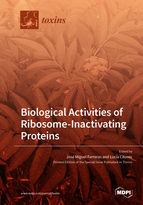Biological Activities of Ribosome-Inactivating Proteins
A special issue of Toxins (ISSN 2072-6651).
Deadline for manuscript submissions: closed (31 July 2022) | Viewed by 29682
Special Issue Editors
Interests: ribosome-inactivating proteins (RIPs); immunotoxins; protein synthesis inhibition; ribotoxins; structure–activity relationship
Special Issues, Collections and Topics in MDPI journals
Interests: ribosome-inactivating proteins (RIPs); immunotoxins; protein synthesis inhibition; ribotoxins; protein translocation; intracellular transport; apoptosis
Special Issues, Collections and Topics in MDPI journals
Special Issue Information
Dear Colleagues,
Ribosome-inactivating proteins (RIPs) are rRNA N-glycosylases (EC 3.2.2.22) isolated mainly from plants and some bacteria that specifically catalyze the hydrolysis of the second N-glycosidic bond from the GAGA tetraloop located in the Sarcin Ricin Loop (SRL) of the large ribosomal RNA. Because the SRL is crucial for anchoring the elongation factors on the ribosome, depurination causes the irreversible inactivation of ribosomes. In addition, RIPs usually display other enzymatic activities, being the most relevant their polynucleotide:adenosine glycosylase activity on all kinds of nucleic acids. RIPs have been classified into two types depending on the presence (type 2 RIPs) or the absence (type 1 RIPs) of a lectin chain (B chain). The presence of the B chain may turn type 2 RIPs into powerful toxins, such as ricin or abrin. Regardless, despite the absence of the B chain, type 1 RIPs, at higher concentrations, are also able to enter into cells and display toxicity to cells and animals.
The exact biological role that RIPs play remains unknown, but it is thought to represent a defense mechanism of a plant against pathogens and predators.
As a consequence of their enzymatic action, RIPs display several biological activities, including antiviral, antibacterial, antifungal, antifeedant, and antiproliferative activities, which may be relevant to their functions and biotechnological applications.
The most promising applications of RIPs in experimental medicine, especially in anticancer therapy, are related to their use as a component of immunotoxins, in which the RIP is linked to antibodies that mediate their binding and internalization by malignant cells. In agriculture, RIPs have been shown to increase resistance against viruses, fungi, and insects in transgenic plants.
The focus of this Special Issue of Toxins will be on the biological activities of RIPs that may be relevant to their biological functions and biotechnological applications, as well as on the elucidation of the structure-activity relationships of these proteins.
Prof. Dr. José Miguel Ferreras
Prof. Dr. Lucía Citores
Guest Editors
Manuscript Submission Information
Manuscripts should be submitted online at www.mdpi.com by registering and logging in to this website. Once you are registered, click here to go to the submission form. Manuscripts can be submitted until the deadline. All submissions that pass pre-check are peer-reviewed. Accepted papers will be published continuously in the journal (as soon as accepted) and will be listed together on the special issue website. Research articles, review articles as well as short communications are invited. For planned papers, a title and short abstract (about 100 words) can be sent to the Editorial Office for announcement on this website.
Submitted manuscripts should not have been published previously, nor be under consideration for publication elsewhere (except conference proceedings papers). All manuscripts are thoroughly refereed through a double-blind peer-review process. A guide for authors and other relevant information for submission of manuscripts is available on the Instructions for Authors page. Toxins is an international peer-reviewed open access monthly journal published by MDPI.
Please visit the Instructions for Authors page before submitting a manuscript. The Article Processing Charge (APC) for publication in this open access journal is 2700 CHF (Swiss Francs). Submitted papers should be well formatted and use good English. Authors may use MDPI's English editing service prior to publication or during author revisions.
Keywords
- antifeedant
- antifungal
- antitumoral
- antiviral
- apoptosis
- immunotoxin
- ribosome-inactivating protein (RIP)
- rRNA N-glycosylase
Related Special Issue
- Biological Activities of Ribosome Inactivating Proteins II in Toxins (4 articles)








